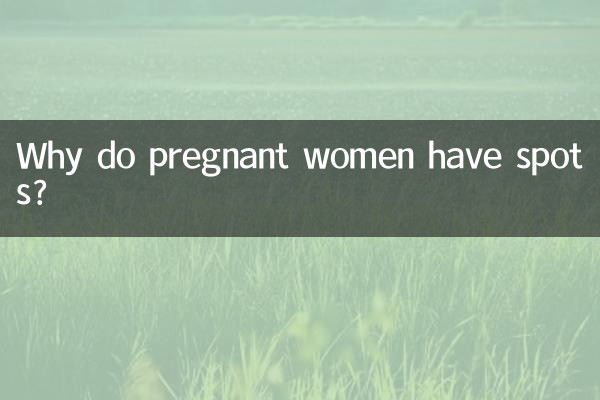Why do pregnant women have spots?
Pregnancy is a special period in a woman's life. Not only will her body undergo many changes, her skin will also undergo some obvious changes, the most common of which is spots. This phenomenon is medically known as "pregnancy spots" or "chloasma." So, why do pregnant women tend to develop spots? This article will analyze the reasons from a scientific perspective and provide relevant data and response suggestions.
1. Causes of pregnancy spots

The appearance of pregnancy spots is mainly related to changes in hormone levels, ultraviolet exposure and genetic factors. The following is an analysis of the specific reasons:
| reason | illustrate |
|---|---|
| changes in hormone levels | During pregnancy, estrogen and progesterone levels increase significantly, stimulating the activity of melanocytes and causing pigmentation. |
| UV irradiation | Ultraviolet rays will intensify the production of melanin. During pregnancy, the skin is more sensitive to ultraviolet rays and is more likely to form spots. |
| genetic factors | Women with a family history of the condition are more likely to develop pregnancy spots, suggesting genetic factors play a role. |
| nutritional deficiencies | Lack of vitamin C, vitamin E and other antioxidant substances may lead to a decrease in skin repair ability and aggravate spots. |
2. High incidence areas of pregnancy spots
Pregnancy spots usually appear on exposed areas such as the face, neck, and back of hands. The specific distribution is as follows:
| parts | Probability of occurrence |
|---|---|
| Face (cheekbones, forehead) | More than 80% |
| neck | 30%-40% |
| back of hand | 20%-30% |
3. How to prevent and improve pregnancy spots
Although pregnancy spots are a common phenomenon during pregnancy, their effects can be reduced with scientific care. Here are some suggestions:
1.sun protection: Ultraviolet rays are the "accomplice" of pregnancy spots, so you should apply physical sunscreen (SPF30 or above) when going out during pregnancy, and wear a sun hat or use a parasol.
2.balanced diet: Intake more foods rich in vitamin C and vitamin E, such as citrus fruits, nuts, green leafy vegetables, etc., to help inhibit melanin production.
3.Gentle skin care: Avoid using irritating skin care products, choose gentle cleansing and moisturizing products to maintain skin water and oil balance.
4.Get enough sleep: Lack of sleep will aggravate pigmentation. Pregnant women should ensure 7-8 hours of sleep every day.
4. The time it takes for pregnancy spots to subside
Pregnancy spots usually fade after delivery, but the exact timing varies from person to person. Here are the relevant data:
| time | Regression |
|---|---|
| 3-6 months after delivery | About 50% of women’s spots are significantly reduced |
| 1 year after delivery | About 70% of women’s spots have basically disappeared |
| 2 years postpartum | A small number of female spots may persist |
5. When Do You Need Medical Treatment?
If pregnancy spots do not disappear for a long time after delivery, or are accompanied by other skin problems (such as itching, redness and swelling), it is recommended to consult a dermatologist in time. Your doctor may recommend the following treatment options:
-topical medications: Such as hydroquinone cream, retinoic acid cream, etc., which need to be used under the guidance of a doctor.
-laser treatment: Suitable for stubborn spots, but lactating women should choose carefully.
Summarize
Spots during pregnancy are a normal physiological phenomenon, mainly related to factors such as hormonal changes and ultraviolet exposure. Through scientific care and preventive measures, the impact of pregnancy spots can be effectively reduced. In most cases, the spots will gradually fade after delivery and there is no need to be overly anxious. If the problem is serious, it is recommended to seek help from a professional doctor.

check the details

check the details